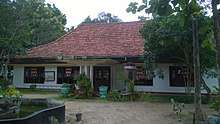Uththararama Purana Vihara, Udugampola
| Uththararama Purana Vihara | |
|---|---|
| උත්තරාරාම පුරාණ විහාරය | |
 The preaching hall and old Pintaliya | |
| Basic information | |
| Location | Udugampola, Sri Lanka |
| Geographic coordinates | 07°07′45.7″N 79°58′58.2″E / 7.129361°N 79.982833°ECoordinates: 07°07′45.7″N 79°58′58.2″E / 7.129361°N 79.982833°E |
| Affiliation | Buddhism |
| District | Gampaha |
| Province | Western Province |
| Heritage designation | Archaeological protected monument (8 July 2005) |
| Architectural type | Buddhist Temple |
Uththararama Purana Vihara (also known as Maligagodella Vihara) is a historic Buddhist temple situated at Udugampola in the Western province, Sri Lanka. The temple is located on Udugampola – Weediyawatta junction road approximately 0.5 km (0.31 mi) away from the Udugampola Roundabout. The temple has been formally recognised by the Government as an archaeological site in Sri Lanka. The designation was declared on 7 July 2005 under the government Gazette number 1401.[1]
History
The historical chronicles such as Rajaveliya and Alakeshwara Yuddhaya reveal that the Udugampola and its surrounding area was a provincial kingdom during the Kotte period.[2] According to these resources, the elder of three of sons of king Parakramabahu VIII (1484-1505) became the king of Kingdom of Kotte by the name of Dharma Parakramabahu while the second son prince Thaniya Wallabha lived in the principality of Madampe.[3] The third son, prince Sakalakala Wallabha lived in that of Udugampola as a viceroy[4] The evidence about the existence of a palace in Udugampola is proved by the copper plate, Kadirana Sannasa which was discovered in Kadirana cinnamon plantation near Negombo. The Sannasa records a donation made to a Brahmin by the king at a royal assembly held in his new palace at Udugampola on new moon day of Poson (18 June 1517) when a full solar eclipse was sighted.[5][6]
According to the archaeological evidences found around the area, it is believe that the place called Maligagodella (Mound of Palace) where the Uththararama temple stands today to be the place where the palace of King Sakalakala Wallabha was situated. There are some ruins still can be seen in the locality including remains of an ancient pond with retaining walls of masonry, and some stone works. The ancient pond, Pathaha Pokuna adjoining the Uththararama temple has been identified as the bathing pool of the king.[7]
References
- ↑ "Gazette". The Gazette of the Democratic Socialist Republic of Sri Lanka. 1401. 8 July 2005.
- ↑ Wijesuriya, Dinithi (2015). "Administration of Udugampola, sub kingdom: A Historical and Archaeological Legacy". University of Kelaniya. Retrieved 12 July 2017.
- ↑ "The Kandyan Rebellion". The Sunday Times (Sri Lanka). 21 December 2008. Retrieved 7 July 2017.
- ↑ "The annual Nanumura Mangallaya of the Tanivelle Devalaya today". The Island (Sri Lanka). 16 August 2013. Retrieved 12 July 2017.
- ↑ Royal Asiatic Society of Great Britain and Ireland. Ceylon Branch, Colombo (1873). Journal of the Ceylon Branch of the Royal Asiatic Society. 5. Colombo Apothecaries Company, 1873. pp. 75, 76, 77.
- ↑ Sōmaratna, G.P.V. (1975). The Political History of the Kingdom of Kotte, 1400-1521. Kotte: University of Michigan. p. 328.
- ↑ "Cultural background of the Minuwangoda Division". Minuwangoda Urban Council. Retrieved 30 June 2017.